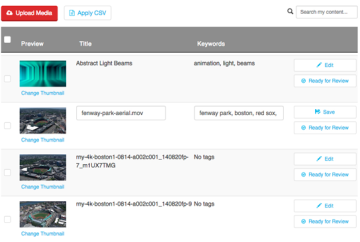New Contributors Can Also Submit R3D Files Without Rendering
The new VideoBlocks Marketplace, launched this week, is aiming to put a good deal of the profits from the stock footage business back into the hands of content creators by returning 100% of the proceeds from their individual sales at VideoBlocks.com. In the process, the subscription-based seller of royalty-free stock video, backgrounds and After Effects hopes to improve the range and depth of its content and provide a more valuable service for customers and contributors alike.
The company is soliciting contributors at a new web portal and getting footage online now. When sales begin in April, VideoBlocks contributors will receive $19–$49 per After Effects template, $49 per HD clip and $199 per 4K clip downloaded by customers. A member analytics section will let contributors track their earnings to see when and how their footage is being purchased.
CEO Joel Holland
According to VideoBlocks CEO Joel Holland, making it attractive and easy for new contributors to submit their libraries—especially in 4K—will give end users more diverse options at crunch time. “We launched VideoBlocks [a digitized version of Holland’s original mail-based DVD stock company, Footage Firm] in 2010 to make premium stock video affordable to everyone, regardless of budget,” he says. “But our customers wanted more choice. We came up with this concept of the Marketplace to provide a deeper library to our customers but also price points that were much more reasonable than Shutterstock or Pond5.” Holland says VideoBlocks’ 100,000 subscribers, who get access to unlimited content, spend on average $1 per clip.
The Netflix-style monthly subscription model keeps prices low for customers, he says, pushing more potential profit to contributors. “The other stock footage companies take 70% of your profits as a contributor, and you only keep 30. By allowing our contributors to keep 100%, that would allow us to drop the price 40% to our customers, and the contributors would still make twice as much money. That’s where the math got really interesting.” Unlike with some competitors, contributors do not sign exclusivity agreements with VideoBlocks and can continue to sell their footage anywhere else they choose.
The new marketplace is built with 4K footage in mind and features a streamlined upload and metadata input process that should ease the pain points for those already shooting most of their footage at higher resolutions. “Right now, the other stock footage companies can’t accept Red’s R3D as a file type,” says Holland. “Shooters have to render it out as a Photo-JPEG and on those sites upload that output, then go back and upload the source file to connect them. It’s a very cumbersome process. We’re the first group to be able to accept R3D files right out of the camera. It took us a very long time to get there, but we built our own custom encoding platform to be able to offer this to our contributors.”
With bigger files also comes more metadata, something Holland is well aware of. “We make it easy for current Shutterstock and Pond5 contributors by letting them submit their metadata CSVs in any way they have them formatted, including for those other services.” If a contributor’s footage is rejected for reasons of quality, a VideoBlocks reviewer will explain with detailed notes why it didn’t make the cut and how to improve it for future submissions. “That’s not something you get at other sites, who never give you an explanation why it was rejected in the first place,” says Holland.
Contributors can drag and drop release forms, media and metadata via a secure FTP or with VideoBlocks own web-based uploader. The site accepts both footage and animation at HD and 4K resolution.
During the marketplace’s beta phase, which launched in November, contributors went through a review-and-approval process before they received an invitation to participate. Those who already had Shutterstock and Pond5 portfolios, like new Marketplace contributors Dan Talson and Helen Sarah Fields, were fast-tracked by VideoBlocks into the online library.
Known on Shutterstock for his gorgeous travel time-lapse footage in HD and 4K and music-scene clips that include a hip, elderly DJ spinning with a pair of Victrolas, Talson says the marketplace’s potential far outweighed his initial uncertainty about submitting his work to a new outlet. “Its always a risk as a submitter to commit our time and energies to a new agency, but the new marketplace came along with an offer that is very different from all the other sites, namely the commission rate. No other agency offers close to this, as VideoBlocks has the subscription side of the business that allows them to absorb the costs. I think this is something worth exploring.”
Fields shoots primarily in 4K and was drawn to VideoBlocks’ simple and robust way of handling high-resolution footage. “VideoBlocks are putting an emphasis on 4K in a very proactive way and have been very helpful in terms of making it easy for me to go through the slightly painful process of outputting and transferring so many large files,” she says. “As an industry, we’ve been avoiding taking the 4K bull by the horns for a while, but it’s time to get on with it and that’s exactly what VideoBlocks is doing. They struck me as determined to stay a step ahead of the technology that our industry is structured around, without sacrificing sensitivity towards what the creatives are trying to achieve.” Fields was also impressed by the company’s progressive “pro-contributor” attitude and felt respected as both an artist and entrepreneur from the start. “It’s easy for agencies to forget customer service includes providing good service to contributors,” she says. “My experience with VideoBlocks has been quite the opposite. It’s the benefit of joining with an agency in the building—you have the opportunity to learn, grow and achieve together. It’s incredibly exciting.”
Both Talson and Fields say the entire process has been smooth since they joined during the beta phase in December. “VB has helped ingest my content using my CSV file,” says Talson, “and taken on most of the heavy work of getting the content online and ready for sale.”

